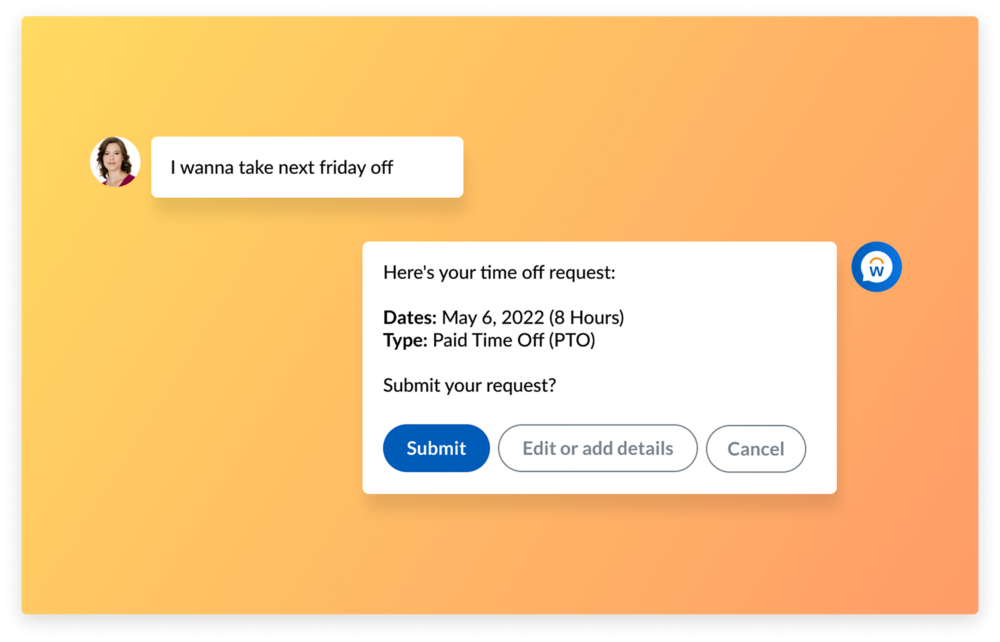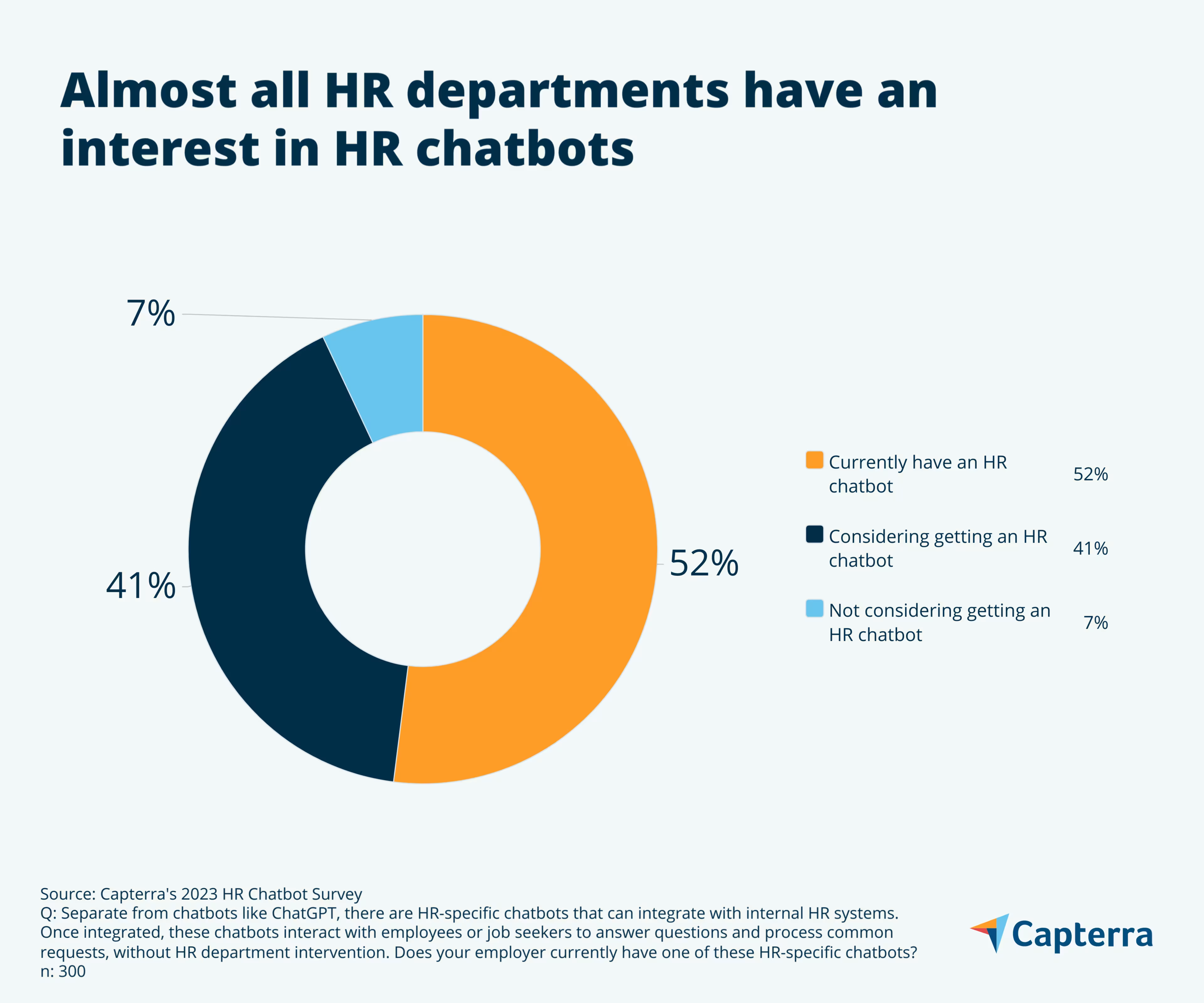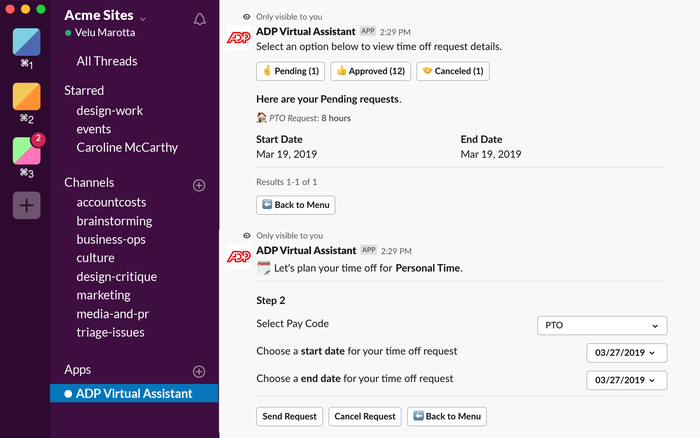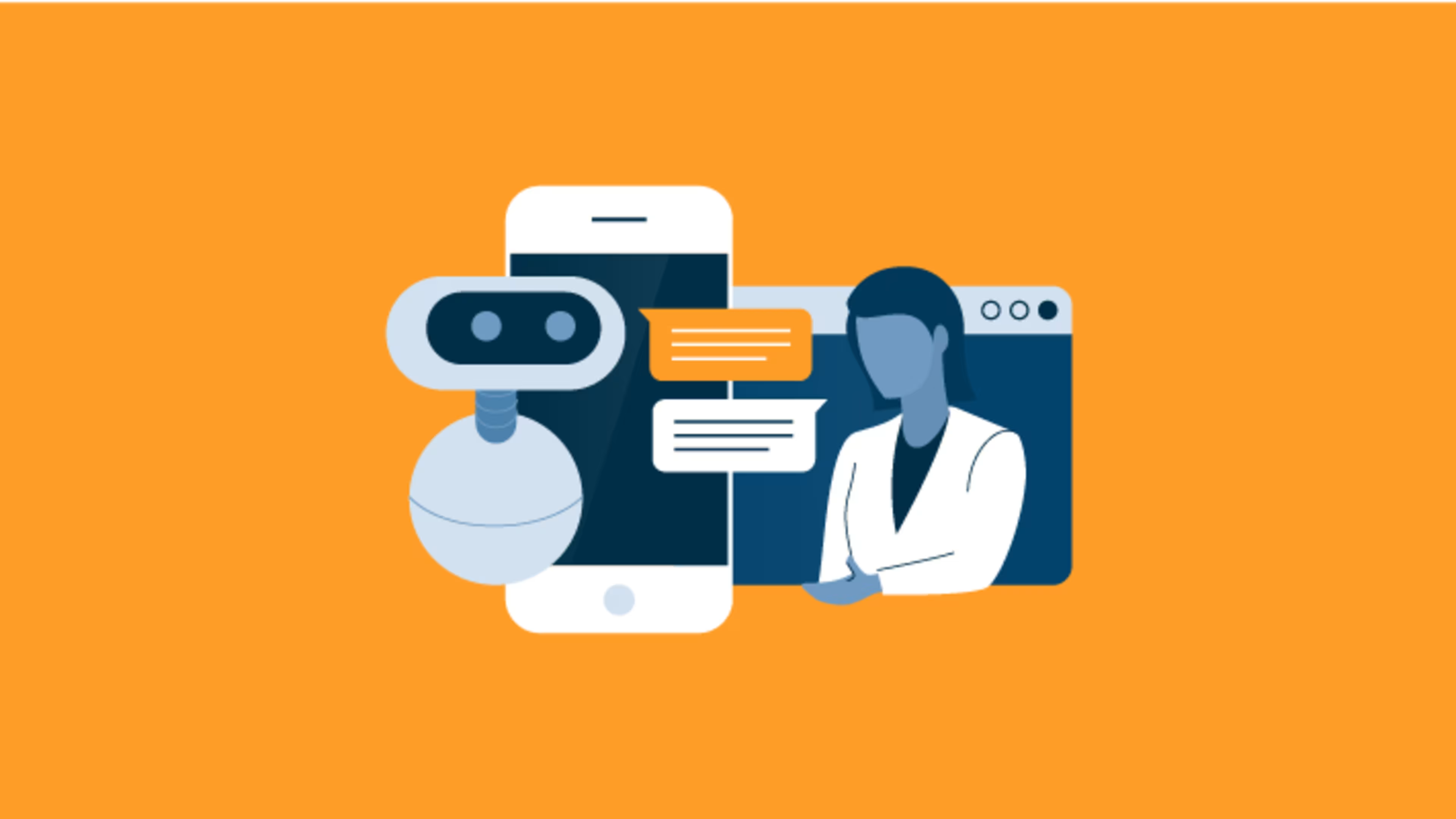Nearly half (49%) of HR employees at companies that use HR chatbots say they've received a complaint from an employee or job seeker about the chatbot's performance.
This report is part two in a series on HR and chatbots. Check out part one, about how HR departments are using generative AI chatbots to create HR content, here.
While generative AI chatbots like ChatGPT have dominated the headlines lately, another breed of chatbot could prove to be the true HR disruptor when it's all said and done.
Dedicated HR chatbots that integrate with internal HR systems and act as a virtual HR assistant—providing information, answering questions, and processing common requests for employees and job seekers alike—have flooded the market and piqued the interest of companies everywhere. In our survey of 300 HR employees in the U.S., nearly all respondents say their department either already has an HR chatbot or is considering getting one.*
The benefits of a chatbot automating a bulk of your service delivery can't be overstated. But with nearly half (49%) of surveyed HR chatbot users saying they've received a complaint from an employee or job seeker about their chatbot's performance, it's clear that this tech isn't perfect out of the box.
Purchase a bad HR chatbot product or implement it poorly, and it could leave users frustrated or cause your department to spend more time fixing the chatbot's mistakes than you spent on service delivery in the first place.
In this report, we'll break down the rest of our survey results to understand why HR departments are so excited about HR chatbots, what challenges users have encountered with their HR chatbot, and what you need to do before implementing an HR chatbot in your own organization.
/ Key Findings
1. HR chatbot interest is on the rise: 52% of HR departments already have an HR chatbot that integrates with internal HR systems, while 41% are considering implementing one.
2. HR chatbots receive high praise, but employees still have concerns: While 94% of HR employees who use an HR chatbot rate their chatbot as good or excellent, only 67% are completely confident their chatbot is delivering accurate information. Even fewer (60%) are completely confident their chatbot is correctly processing requests.
3. Nearly half of HR departments with a chatbot have received complaints about it: 49% of HR employees at companies with an HR chatbot have received at least one complaint from an employee or job seeker about their chatbot’s performance.
HR chatbots are going mainstream
HR chatbots are not a new invention. In fact, we wrote about the ways they were changing the employee experience nearly three years ago. So why are we talking about them now?
One reason is that, since that time, HR chatbots have evolved from a niche offering only sold by a handful of vendors to a more mainstream feature found in sought-after HR suites. Workday's "Workday Assistant" (launched in 2020), ADP's "Intelligent Self-Service" (launched in 2022), and Bullhorn's "Chatbot" (also launched in 2022) are just a few examples.

An example of Workday Assistant in action[1]
In other words, chatbots are showing up in more and more talent management and applicant tracking systems that HR departments are already using. These chatbots aren't appearing reluctantly, however. HR departments are becoming keen on implementing chatbots for the potential time-savings they can provide.
Case in point: In our survey, HR employees say they spend an average of 26 hours out of a typical 40-hour workweek doing HR service delivery. For most HR departments, service delivery represents their biggest productivity drain. By offloading some of this burden to a chatbot that can answer simple questions and process basic requests on its own, HR departments are freed up to focus on more complex service needs or bigger, strategic priorities.
With more HR chatbot product options, and a clear use case for investing in one, HR chatbots are on a path to becoming as ubiquitous as chatbots have become in customer service. Compared to 2019, when only 10% of HR departments were experimenting with chatbots according to Gartner, in our survey, 93% of U.S. HR employees say they work at a company that either already has an HR chatbot in place or is considering getting one.[2]

If you're in the market for an HR chatbot, these are exciting times. Looking at our data from current HR chatbots users, however, reveals that this tech has the potential to do more harm than good if you aren't careful.
HR says chatbots perform well, but mistakes still happen
Potential buyers need to know how HR chatbots perform in the real world. According to our data, the results are a mixed bag.
On the one hand, reviews of chatbots are overwhelmingly positive. Of the HR employees in our survey who work at a company with an HR chatbot, 94% rate the quality of their chatbot as "good" or "excellent." The other six percent rate their chatbot as "fair," and no one rates their chatbot as "poor."

Overall, HR employees say chatbots perform admirably. That being said, this same group is at least a little skeptical that their chatbot is delivering satisfactory results every time:
Only two-thirds (67%) of HR employees with a chatbot are completely confident that the chatbot is delivering accurate information to employees or job seekers who use it.
Fewer than that (60%) are completely confident that their chatbot is correctly processing requests, such as updating personal information, changing benefits elections, or requesting time off.
This skepticism is warranted considering common reasons why chatbots can fail to deliver. For example, early iterations of chatbots that are entirely scripted and use decision trees to guide users to the correct information or work process rely on accurate pathing established during setup. If the HR departments that customize these chatbots don't account for every possible path a user could take to find information they need or perform a certain task, employees and job seekers can end up stuck or routed to the wrong solution.
Newer HR chatbots powered by artificial intelligence (AI) have solved this by using language processing to better understand what users need, instead of forcing them to choose from a bank of preset pathing options. But even though these chatbots are better at being conversational and translating speech into pulling the correct data or performing the right task, errors can still happen:
Queries can be misinterpreted or not understood at all: Not all chatbots can interpret slang or typos, and voice-enabled chatbots can struggle with heavy accents. On top of this, language support varies widely from chatbot to chatbot, so if you have a multilingual workforce, anyone who speaks an unsupported language won't be able to use the chatbot.
Chatbots can give bad—or even illegal—advice: HR departments know the rules for how they can and can't help employees, but chatbots may not know all of these nuances or when to direct complex questions/requests to a human HR rep. For example, if an employee asks for a medical plan recommendation based on a diagnosis in their family, the chatbot should not give a recommendation but it might anyway.
Even if these errors are few and far between, it doesn't take much for employees or job seekers to grow frustrated with chatbots and let the company know about it. In our survey, close to half (49%) of HR employees at a company with an HR chatbot say they've received at least one complaint from an end user about its performance.

All it takes is a few bad interactions for users to lose trust in HR service chatbots altogether, resulting in them dropping the tool in favor of contacting your HR department directly and eliminating any time-savings you hoped to achieve with the chatbot in the first place.
Minimize HR chatbot risk with these tips and best practices
With such a small margin of error for an HR chatbot implementation, HR departments need to purchase the right product and set it up correctly if they hope to achieve long-lasting usage. First impressions matter a lot with chatbots, and if you don't provide a great experience right off the bat, employees and job seekers won't fully embrace it.
With that in mind, here are some tips and best practices to increase your odds of HR chatbot success.
1. Prioritize data protection when talking to chatbot vendors
HR chatbots need access to sensitive HR information in order to work properly. When you're evaluating different chatbot products, talk to vendors about what privacy laws they're beholden to, what legal concerns are covered in your service-level agreement, and how they intend to keep your HR data secure.
2. Ensure all of your HR policy information is up-to-date
Whether a chatbot can pull from your HRMS software automatically or you need to feed it data manually, if that data isn't correct, your chatbot is doomed to fail from the beginning. An HR chatbot implementation is the perfect excuse to pore through your policy information to ensure it's correct and up-to-date.
3. Test, test, and test again
The only way to know for sure if an HR chatbot will perform as intended in a live scenario is to first put it through its paces in a controlled environment. As a department, you should not only ensure that the chatbot handles routine questions and tasks well, but also try to trip it up and see how it responds. If your chatbot can't provide the right information, or doesn't redirect users to your department when it comes across a complex or dicey issue, keep testing and tweaking.
4. Implement one chatbot at a time (and don't have more than two)
The fine-tuning needed to make an HR chatbot work well requires dedicated resources and effort. If you spread your department too thin between multiple chatbot implementations, you risk one of the chatbots falling through the cracks. On top of this, having too many different chatbots for different HR needs bloats cost and doesn't provide a seamless user experience (employees will find having to use different chatbots to request PTO and change benefits elections too cumbersome).
So while there are dedicated chatbots for a variety of HR functions out there—recruiting, onboarding, engagement surveys, training, performance management, etc.—best practice is to not have more than two. Ideally, you should have one job seeker-facing chatbot in your recruiting software, and one employee-facing chatbot for all internal needs in your talent management system.
5. Integrate chatbots with the tools employees are already using
Instead of siloing off your HR chatbot in a system that users have to log in to separately, you can reduce the friction required to use it by integrating your chatbot with the tools employees already use in their day-to-day. For example, many HR chatbots offer integrations with collaboration tools like Slack and Microsoft Teams so that employees can start a chatbot request just as easily as they can start a conversation with a coworker.

ADP Virtual Assistant integration with Slack[3]
6. Always supply an out for a user to talk to a human
The explosive growth in the HR chatbot space has led Gartner to predict that 75% of HR inquiries will be initiated through conversational AI chatbots by the end of this year.[4] Very soon, we could be seeing a majority of companies handing off a majority of their HR service needs to technology.
That being said, not all employees will be comfortable using a chatbot for their HR needs, and a chatbot certainly can't handle all of the complex, nuanced issues that come up in the workplace every day. As tempting as it is to push these increasingly-capable tools to fully automate your HR service function, every interaction with a chatbot should have the option for an employee or job seeker to talk to a human being.
If you're in the market for HR chatbot software, we have a few options for you:
Otherwise, if you're interested in reading more reports like this one, check out:
Note: The applications shown in this article are an example to show a feature in context and are not intended as endorsements or recommendations. They were obtained from sources believed to be reliable at the time of publication.
